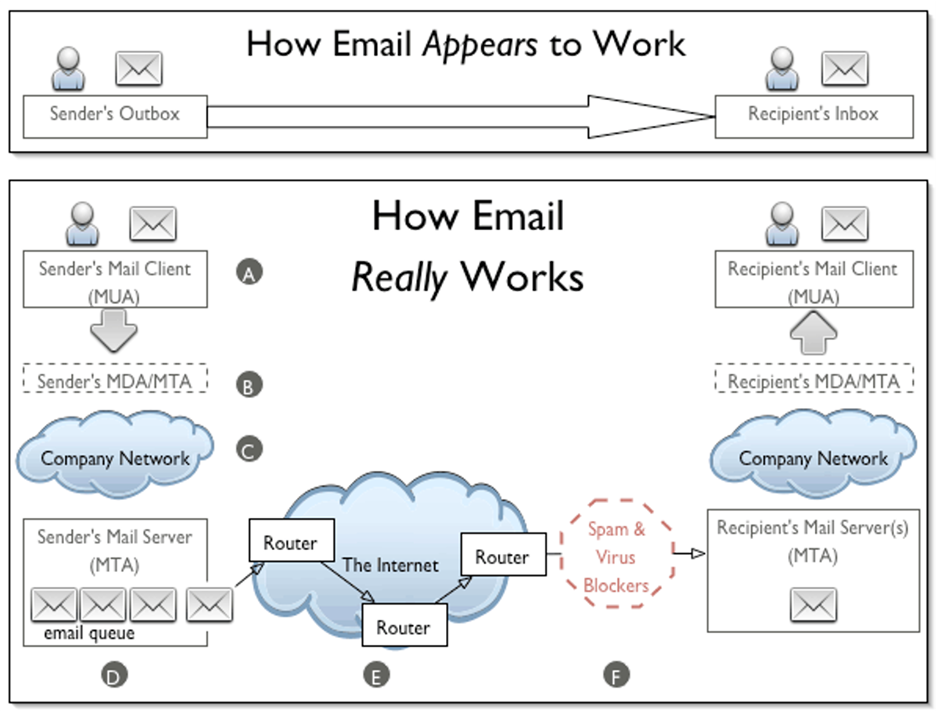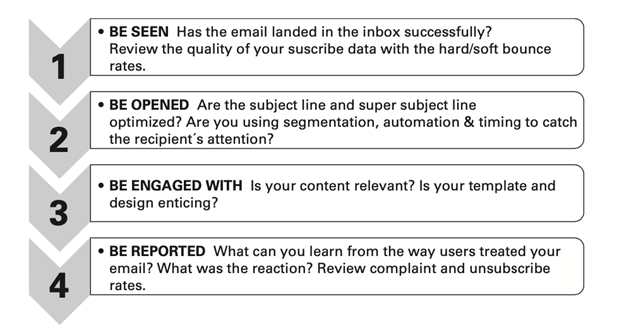The four key stages of email marketing
Recently I had the honour of teaching a group of eager University students who wanted to learn everything there is to know about email marketing. It promised to be a fantastic experience, especially given the venue: the stunning city of Barcelona.
But there was a catch. I had to teach these students everything there was to know in only three weeks.
We email marketers know there is a lot to learn about doing email the right way, and I will be the first to admit I am still learning (and will always be learning!) something new about email.
So, writing the course got me thinking. What are all of the essential ingredients you need in order to send your first email campaign or start your first email journey?
My first thought was that the strategy, the design, the copy and the building of the campaign were obviously crucial components. But, the more I thought about it, the more I realised that things like choosing a fit-for-purpose ESP, configuring the ESP (depending on what was chosen) and what are generally seen as the technical aspects of email, such as domain infrastructure, DMARC, BIMI, and deliverability, were also absolutely vital.
This got me thinking. With all of the focus on design, do we spend enough time reviewing and configuring the technical aspect of email marketing? The more I considered it, the more I realised that I was going to have to present my students with a seriously hefty curriculum. After all, I wanted to prepare them as best I could for their future careers - and that meant teaching them the technical as well as the creative and strategic aspects of email marketing.
Email tech - there’s more to it than you might think!
There is a big difference between learning about email marketing in a classroom setting to the demands of a real-world email marketing role. A professional marketer dedicates time to their job, of course, but that does not mean it is not without distractions (work commitments, family life, social life etc.). However, that initial investment of 3 weeks will pay dividends to these students who "did not realise there was so much involved with email!'.
This is the common theme we all face as email marketers, whether at an agency or a brand. Email is a misunderstood channel. Many do not understand its levels of complexity. They don’t realise the need for the dedicated time to spend on things like DMARC, for authenticating our sending domain, testing out BIMI and so on.
These may not be the sexiest elements of email marketing. They don’t involve gorgeous designs, creative tactics, or fun new customer-facing tech., But they are critical. The longer these technical areas have been neglected or deprioritised, the more problems that arise. Ignoring email tech means increasingly frequent problems and downtime, meaning that you’ll have to divert more and more time and resources to firefighting.
Let’s spend the next few minutes on what I consider the basic things you need to understand when it comes to email tech:
1. Understand the email journey
The best place to start when understanding email tech is the technical journey that an email goes on. A brilliant diagram from Oasis-Cloud illustrates what happens once we press send.

Source: Oasis-Cloud, (2022) https://www.oasis-open.org/khelp/kmlm/user_help/html/how_email_works.html
This diagram shows the number of stages an email goes through before it lands in the inbox. It is essential to know about each of these processes if you are going to understand your email operation truly.
2. Learn what impacts deliverability
Deliverability is affected by several factors, but, for our purposes, I suggest you learn about three main ones:
- Engagement of subscribers
- Sending patterns – frequency and volume
- Content - if it is not engaging/driving action, this can reduce engagement and links to the first area
While you may not think that you are devoting much time to optimising deliverability, I can assure you that you are. Every time you test email design, copy or image, you will be impacting engagement, which impacts deliverability.
So, for example, if your email programme consistently fails to engage your audience, this would be an area of concern, particularly when viewed through the deliverability lens.
There are four key areas to focus on when analysing email deliverability:
- Sender reputation – ranking in the inbox. Monitor your sender's reputation closely – is it high, medium or low? There are tools which can help out with this. For example, if many recipients are using Gmail, you can use Google Postmaster Tools. The other mailbox providers, such as Yahoo, Outlook etc., have their alternatives.
- List hygiene – comb through your list, looking for inactive subscribers and studying the quality of your subscriber data. Consider how you validate your data and whether your data sources are reliable.
- Email content – measure engagement & unengagement
- Your email infrastructure - DMARC. This brings me neatly to my next tip.
3. Understand authentication
You will notice in the diagram above that email verification is mentioned.. So what verification approaches are there in email?
There are several forms of email verification:
- SPF record – standard email authentication method, DNS record for specific mail servers to send for that specific company.
- DKIM - cryptographic authentication – similar to SPF but adds another layer of authentication.
- BIMI – relatively new, launched last year in Gmail, growing in adoption.
- DMARC – protecting domains from unauthorised use.
The number of brands not putting DMARC authentication at the top of their email marketing to-do list still astonishes me. While DMARC will not prevent spam, the more verification approaches undertaken, the less chance there is of unauthorised phishing in the inbox. That is good news for everyone: the recipient, the mailbox provider and the brand itself.
To verify with your recipients that the email your organisation is sending is from you, you can also use BIMI. BIMI allows you to add an icon next to your sender's name (in most mailbox providers, anyway. Some still don’t support BIMI - see the diagram below!).
Litmus has an excellent blog about this with implementation tips. It’s worth checking out if this is something left to action in your organisation.

Source: Litmus (2022), https://www.litmus.com/blog/what-is-bimi-and-why-should-email-marketers-care/
There is no ‘quick’ guide to email marketing. It’s all important.
So what did these students learn about email marketing?
It is only once you understand all of the facets of email marketing, including the technical ones, that you truly begin to understand the channel.
They also learned something that we as an industry keep forgetting: that it’s all about the customer.
I was lucky enough to have an awesome set of students who,, as part of their final project, created an automated welcome email journey to new customers. This was documented in a report detailing their strategy and the rationale behind their decisions based on the specific characteristics of their email subscribers/customers.
That last bit is very important. Marketing as a whole is at its best when the mindset shifts from organisation-centric to customer-centric. It is vital to take a step back and view your email campaigns the way your subscribers will
Time and time again, we see brands copying each other rather than learning from their audiences. Even today, many retail brands are aware that their image-only emails are not viewable to a number of their recipients (based on device data), but because everyone else is doing it, they continue. It’s an age-old story.
What are the crucial things you need to know to start email marketing?
I’d say that, rather than learning facts about email marketing, a more productive approach would be to learn about its stages.
There are four critical stages to email marketing. I detail them in my multi-award-winning book 'Marketing Strategy: Overcome Common Pitfalls and Create Effective Marketing' as below:

Source: Tiffany, J, (2021), Marketing Strategy: Overcome Common Pitfalls and Create Effective Marketing, Kogan Page
The first stage, 'Be Seen,' is where the 'technical' aspects are important and where, typically, not much time or focus is spent. However, getting this first technical stage right (or wrong!) can significantly impact the success of stages 2, 3 and 4.
If tech isn’t your area of expertise, my advice to you is to try and gain some awareness by joining webinars, following the email geeks on social media, joining events, and reading more about the technical aspects of email.
We have seen with other channels, such as SEO, that the technical aspect becomes increasingly important as we move into a more tech-dependent society. Email is no different.
 Photo by David Pisnoy on Unsplash
Photo by David Pisnoy on Unsplash

 How to resolve AdBlock issue?
How to resolve AdBlock issue? 
 Jenna Tiffany is Founder & Strategy Director at Let'sTalk Strategy providing strategic consultancy services across the digital marketing mix. Jenna is a Chartered Marketer and elected Fellow of the IDM with over ten years’ marketing experience across both B2B and B2C. Jenna has consulted with brands such as Shell, Hilton and World Duty Free to name a few on digital and email marketing strategy.
Jenna Tiffany is Founder & Strategy Director at Let'sTalk Strategy providing strategic consultancy services across the digital marketing mix. Jenna is a Chartered Marketer and elected Fellow of the IDM with over ten years’ marketing experience across both B2B and B2C. Jenna has consulted with brands such as Shell, Hilton and World Duty Free to name a few on digital and email marketing strategy.